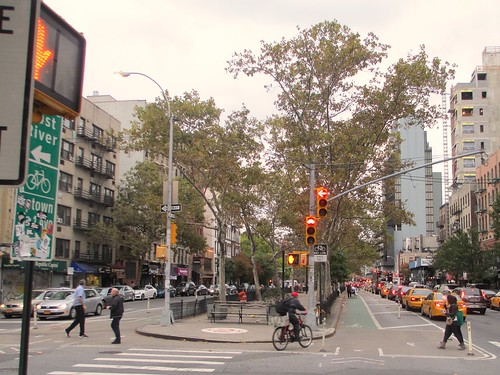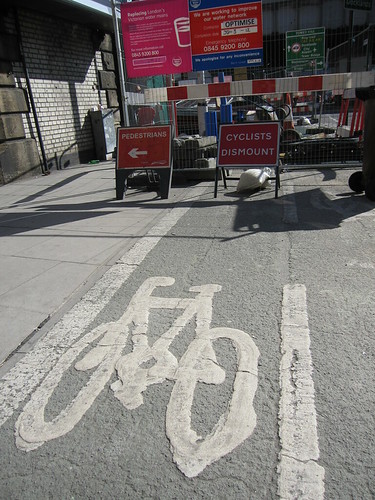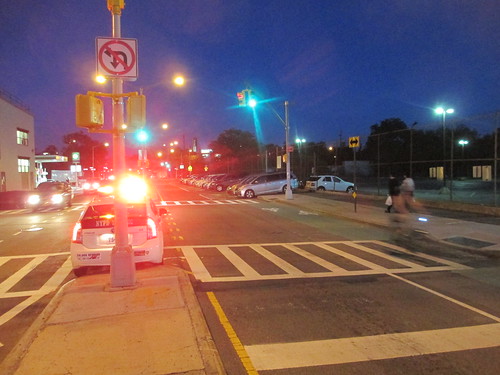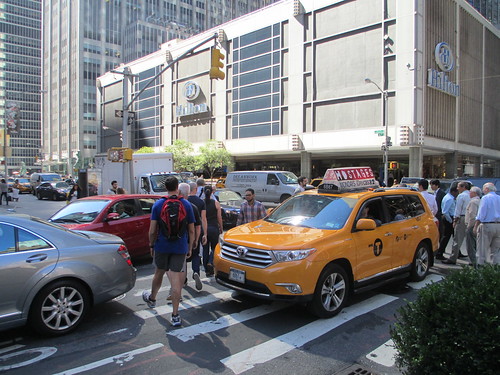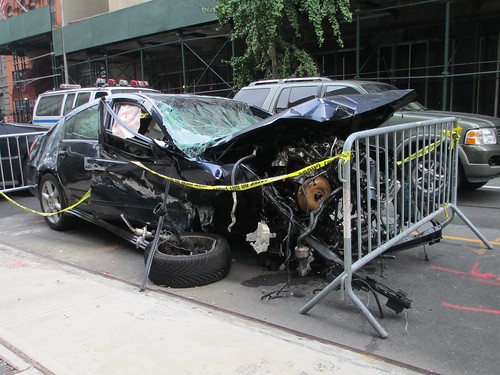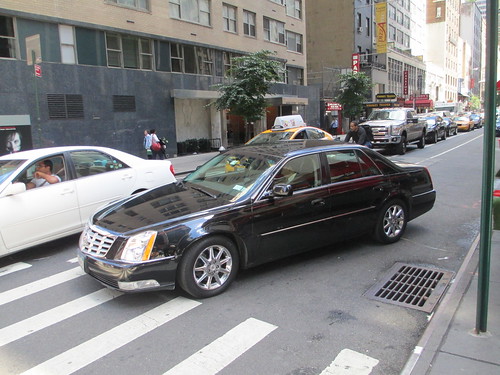Before I got out on my bike, I was anticipating that Monday,
January 9, was going to be my smuggest cycling day since returning to London from New
York in July. A strike by station staff on the London
Underground had brought the busiest bits of the capital’s most important public
transport system to a halt. And, as I sat at home writing initial stories about
what was happening, I noticed account after account of chaos on the roads as
would-be underground users turned to cars and buses to get to work. I imagined
myself slipping casually through the traffic on my bike, warmly congratulating
myself on the excellence of my transport choices.
In the event, the day ended up feeling less like a triumph
and more like a reminder of the acuteness of the transport policy challenges
facing London. By the time I left home to ride to the office, around 10am, the
bus lanes that I’d normally use for the early stages of my journey were choked
with other forms of motor traffic. Progress was so slow I retreated to the side
streets, which in places were little better.
 |
| Traffic backed up on Vauxhall Bridge on January 9: a visible demonstration of London's reliance on its underground. |
The incident dramatised an issue that’s been worrying me for
some time. London ’s
roads become congested when people are emptied out of the underground and other
non-road forms of transport onto the roads. Yet it’s an uncomfortable truth of
campaigns to encourage cycling in inner London
that the vast bulk of the growth in cycle commuting must be coming from a
similar, slow-motion shift from rail-based modes onto already over-stretched
streets. More and more complex demands are being heaped onto constrained roadspace, without much sign of a strategic plan to manage the resulting pressures.
On top of that, I noticed once I got to work how many
twitter users were complaining of having hours spent on buses even on short
journeys. Later in the week, would-be commuters on Southern, the mainline rail
service, would undertake similarly unpleasant journeys during strikes by their
service’s drivers. The stories illustrated the shortcomings of decades of
efforts to encourage cycling. Cycle provision in most of London still consists of signed routes down
backstreets, most of which are growing ever busier and less attractive. It’s
clear that most people will not consider riding on these, even in the most
desperate circumstances.
Faced with placating demand for better cycle provision and
the challenges of congested, polluted roads, Sadiq Khan, London ’s mayor, seems anxious about building
more of the direct, segregated cycle routes that might get such reluctant
cyclists pedalling.
The challenge for everyone in London who wants more, safer
cycling in central London is to devise arguments for better provision that
recognise the new realities. It’s vital as the system accommodates growing
cycling to safeguard road provision for the buses, delivery vehicles, emergency
vehicles and other vital road-users that make up a high proportion of central London ’s current road
users. The challenge is similar for advocates in other big urban centres -
including New York ,
my old home - where people shift to cycle commuting mainly from modes that
don’t depend on the roads.
 |
| Pedestrians spill out of Southwark underground station by the north-south cycle superhighway. How many of them can switch to cycling before the roads get even more congested? |
Yet some of the most influential figures on London ’s transport scene continue to insist
that the conundrum is so simple it barely exists. On January 5, Andrew
Gilligan, London ’s former cycling commissioner,
tweeted a graph from Transport for London ’s
latest “Travel in London ” report that attributed 75 per
cent of London ’s
congestion to “excess traffic”. The conclusion was “blindingly obvious to all
but motorists,” he wrote, dismissively.
A little digging into the statistics for central London fills in the
details of the policy dilemma. Traffic volumes entering Central London fell 3.4
per cent between the June to September quarter in 2015 and the same quarter in
2016, part of a long-term decline that’s seen the volume of motor traffic
entering central London
decline by more than 20 per cent since 2000. Instead of increasing with
declining traffic volumes, however, average traffic speeds in central London - the easiest
available proxy for congestion - fell 3.5 per cent, to 7.8mph. The network’s
capacity is very clearly falling even faster than motor vehicle are going away.
The amount of traffic that it takes for traffic to become “excess” is falling.
It is not clear, either, which part of the traffic can
easily be reduced to alleviate the problem and free up space for cycling. The
same Travel in London report that Andrew
Gilligan quoted says that private cars now account for only 18 per cent of
motor traffic during weekdays in the central London congestion charging zone. The other
vehicles - private-hire cars, taxis, vans and heavy lorries - all have at least
some arguable economic reason to be in the area. They are likely to be more
resistant than private vehicle owners to stopping driving in the area.
 |
| A typical traffic queue on Southwark Bridge: it's not clear crackdowns on private cars or encouragement for cargo bikes will solve this problem. |
One of the most popular suggestions among cyclists for
reducing the traffic is that more of the growing numbers of internet deliveries
being made in central London
could be shifted to cargo bikes. The idea is sufficiently attractive that I
investigated the subject in my day job for a piece about the growing numbers of
cargo bikes I see around central London .
Yet I emerged from interviewing even courier companies that use cargo bikes a
little depressed. While cargo bikes were helping them to make urgent deliveries
despite the heavy traffic, courier companies told me, they would always be a
niche vehicle compared with the vans that were their fleets’ mainstays.
Amid this growing crisis, meanwhile, the one unutterable
suggestion among cycle campaigners is that the building of segregated cycle
superhighways along a number of central London
roads might be contributing to the problem. When Florence Eshalomi, a member of
the London Assembly, asked cyclists on twitter on January 11 whether they
agreed with a senior TfL manager that cycle lanes had had some impact on bus
journeys, the replies mostly struck a similar note.
“Making London
a byword for cycling is more important than bus usage,” one twitter user
replied.
“I think any far measurement of bus delays would show that
excess cars are the main cause,” wrote another. “There aren't that many cycle
lanes.”
The replies drew on the now-conventional wisdom among London cyclists that the 12 miles of new cycle
superhighways in central London
- which I love using, especially when with my children - have had no
significant effect on congestion. The facilities, however, have been put in on
arterial roads that were already operating at or near full capacity. They have,
crucially, introduced new, cyclist-only light phases that can only have
introduced extra waiting time for motor vehicles both on the streets with the
new facilities and those crossing them.
 |
| A bus in a traffic jam by the cycle superhighway on Blackfriars Road: the superhighway has no bearing on what goes on on the rest of the road, it's said. |
While there are plenty of other factors restricting London ’s road capacity,
it seems fanciful to imagine that cycle facilities alone can remove capacity
from busy roads and have little effect on congestion. It is certainly clear the
capacity of London ’s
roads fell around the time the new facilities were built. It is not
unreasonable, it seems to me, for Sadiq Khan and Mike Brown, commissioner of
Transport for London ,
to seek to reduce the effect of any new facilities on congestion before giving
them the go-ahead.
Yet to say that the challenges facing London ’s leaders are hard is very definitely
not to say they are impossible. It is quite clear, for example, that action
that reined in the growth of services such as Uber in central London could have a significant effect.
Private hire vehicles - the vehicles that provide the Uber service - now
account for 12 per cent of traffic in central London on weekdays. Any measure that makes
deliveries to the scores of construction sites in central London more efficient could free up
significant amounts of road space. It is hard to understand why low-emission
vehicles, which take up the same road space as others, remain entirely exempt
from congestion charging.
It is regrettable, meanwhile, that London
relies so heavily on the double-deck New Bus for London given its poor capacity and the time
it takes to load and unload. A wholesale reform and extension of the current
central London
congestion charge to make it more sophisticated and more closely related to the
space each vehicle takes up on the road seems overdue. The mayor should
continue to pursue increases in cycling because bikes provide clean, healthy,
flexible transport. Extra cycling journeys can almost certainly be catered for
more economically than extra journeys on the underground.
It is far too easy, however, for the debate over this
complex issue to slip into glibness. Taxi driver groups slip into this trap
when they claim the simple removal of new cycle paths would restore London ’s roads to flowing
freely. Cycling groups fall into it when they pretend new cycle paths magically
shift London
commuters from wasteful cars onto space-efficient bikes.
The rest of my ride to work on January 9 was a stark
reminder of the risks of ducking serious debate. I encountered drivers engaged
in fierce rows over road space, a furious woman cyclist yelling at a man who
had somehow wronged her and, in van after van, long lines of stressed-looking
delivery drivers and workmen. An air of unhappiness and frustration hung over
everything.
While the scenes were far worse than those on a normal day,
I made an inward vow to renew my efforts to think more seriously in future
about the less acute but still worrying levels of congestion I encounter daily.
If others do the same, it may prove easier to build wide support for the kind
of excellent facility I found myself using towards the end of the trip. Wanting
to take in the scene, I rode over Vauxhall
Bridge










